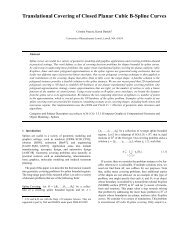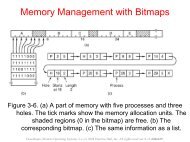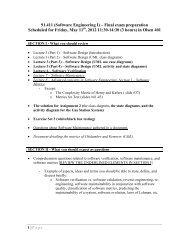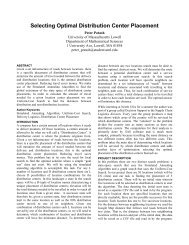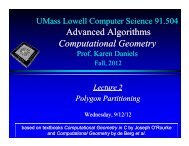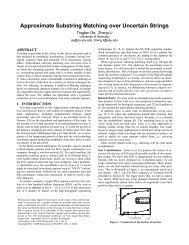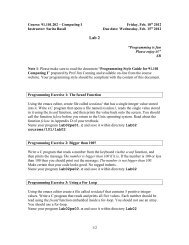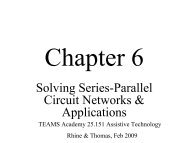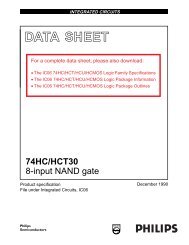Distributed Systems
Distributed Systems
Distributed Systems
Create successful ePaper yourself
Turn your PDF publications into a flip-book with our unique Google optimized e-Paper software.
<strong>Distributed</strong> <strong>Systems</strong><br />
• We will consider distributed systems to be<br />
collections of compute engines in a NORMA<br />
configuration. Information exchange among<br />
systems will be by message passing through some<br />
interconnecting Inter-Process Communication<br />
(IPC) mechanism<br />
• Such configurations are motivated by:<br />
– resource sharing<br />
– enhanced performance<br />
– improved reliability and availability<br />
– modular expandability<br />
1
<strong>Distributed</strong> <strong>Systems</strong><br />
• As with any collection of compute elements, there<br />
are many and varied ways of deploying resources<br />
at the physical level. In general the distinguishing<br />
characteristic at the system software level is the<br />
need to support the exchange of information<br />
among threads which live in different processes<br />
which exist on different physical systems<br />
• This exchange, of course, not only requires<br />
communication channel support, but, perhaps<br />
most importantly, requires synchronization<br />
2
<strong>Distributed</strong> <strong>Systems</strong><br />
• If we assume that a distributed system must<br />
maintain any kind of global state information (a<br />
fundamental requirement of any coordinated<br />
system), then it is fair to ask how such information<br />
can be maintained in a coherent way<br />
• We’ve already seen that this is the crux problem in<br />
a non-distributed system, where we’ve been able<br />
to control mutually exclusive access to shared<br />
resources by employing spin locks as a foundation<br />
for various synchronization primitives (event<br />
counters, semaphores, etc.)<br />
3
<strong>Distributed</strong> <strong>Systems</strong><br />
• In non-distributed systems, however, our spin lock<br />
implementations depended on the memory<br />
interlock provided by UMA and ccNUMA<br />
(memory interlock was a minimum requirement<br />
for Peterson’s algorithm or the Bakery algorithm),<br />
and, for most contemporary systems, we could<br />
leverage machine instructions like the IA-32<br />
XCHG which provided atomic 2 bus-cycle access<br />
• Since distributed systems do not share a common<br />
bus, we do not have even memory interlock to<br />
help us synchronize access to shared components<br />
4
<strong>Distributed</strong> <strong>Systems</strong><br />
• So we have 2 basic challenges in distributed<br />
systems engineering<br />
– What type of communication channels can we establish<br />
to support the inter-host IPC we need to exchange<br />
information <br />
– How can we synchronize the the exchange of<br />
information to make sure that we can provide<br />
coherence semantics to shared global objects <br />
• These primitive problems must be solved to<br />
provide a foundation for any type of distributed<br />
system which shares dynamically changing<br />
information structures among its subscribers<br />
5
<strong>Distributed</strong> <strong>Systems</strong><br />
• One can envision networks of computing systems<br />
that share very little<br />
– UNIX systems using NFS software to share files<br />
– NT systems using CIFS software to share files and<br />
printers<br />
• Other systems (mostly research not commercial)<br />
may share a lot<br />
– Clouds from GA Tech allows generalized objects which<br />
may have embedded threads to be shared among its<br />
community of machines<br />
6
<strong>Distributed</strong> <strong>Systems</strong><br />
• The main issues in distributed systems include:<br />
– Global knowledge<br />
• Which parts of a distributed system must be shared among the<br />
members in a consistent fashion <br />
• To what degree can system control be de-centralized <br />
– Naming<br />
• How are system resources identified and what name spaces can<br />
they be found in <br />
• Is resource replication a sensible de-centralization strategy <br />
– Scalability<br />
• How easily can a distributed system grow <br />
• Will certain software architectures constrain growth <br />
7
<strong>Distributed</strong> <strong>Systems</strong><br />
• The main issues in distributed systems (cont’d):<br />
– Compatibility<br />
• Binary level: an executable image can run on any member<br />
• Execution level: source code compatibility, can compile/run<br />
• Protocol level: most interoperable in heterogeneous<br />
environments. System services accessed with common<br />
protocol framework (NFS, XDR, RPC)<br />
– Process synchronization<br />
• The mutual exclusion, critical section problem<br />
– Resource management<br />
• How are mutually exclusive system resources allocated <br />
• Mutually exclusive resources can lead to deadlock<br />
8
<strong>Distributed</strong> <strong>Systems</strong><br />
• The main issues in distributed systems (cont’d):<br />
– Security<br />
• Authentication: who is on each end of an exchange <br />
• Authorization: do the endpoint threads have the privilege<br />
required for an exchange <br />
– Structure<br />
• Monolithic kernel: one size fits all member systems<br />
• Collective kernel: often microkernel based with a collection of<br />
daemon processes to provide specific resources in each<br />
member’s environment as required by that member. In a<br />
distributed system the microkernel message passing system sits<br />
at the lowest level of the architecture (MACH)<br />
• Object oriented systems: resources are treated as objects which<br />
can be instantiated on member systems…. Mechanism / Policy<br />
9
<strong>Distributed</strong> <strong>Systems</strong><br />
• Whatever the structure of a distributed system, the<br />
actual exchange of information from one member<br />
to another often is based on the Client-Server<br />
computing model<br />
– A client requests access to information kept somewhere<br />
in the system<br />
– A server functionally provides the access on behalf of<br />
the requesting client<br />
– The Ada rendezvous discussed earlier is an example of<br />
a Client-Server model where a client calls an entry<br />
point in a task and the task executes the necessary<br />
operation for the client<br />
10
<strong>Distributed</strong> <strong>Systems</strong><br />
• Client-Server computing often takes place over a<br />
networked environment where an exchange can be<br />
decomposed into a set of layered abstractions as<br />
described in the Open System Interconnect model<br />
– Each layer on one side of the communication is viewed<br />
as communicating with its peer layer on the other side,<br />
and will have little or no knowledge of the layers above<br />
or beneath it<br />
– Exchanges, of course, occur by traveling down through<br />
the layers on the initiator’s side, across the physical<br />
network connect, and then up through the layers on the<br />
receiver’s side<br />
11
Peer Level Communication in a Routed Network<br />
Host A<br />
Host B<br />
Application<br />
Application<br />
Presentation<br />
Presentation<br />
Session<br />
Session<br />
Transport<br />
Transport<br />
Network<br />
Network<br />
Network<br />
Network<br />
Data Link<br />
Data Link<br />
Data Link<br />
Data Link<br />
Physical<br />
Physical<br />
Physical<br />
Physical<br />
Routing<br />
12
Some Examples of OSI Layer Functionality<br />
Application<br />
Presentation<br />
Session<br />
Transport<br />
Network<br />
Data Link<br />
Physical<br />
NFS<br />
XDR FTP<br />
RPC<br />
UDP TCP<br />
IP<br />
802.3<br />
100Base -T<br />
13
Remote Procedure Call Paradigm<br />
14
• Design issues in RPC<br />
<strong>Distributed</strong> <strong>Systems</strong><br />
– Structure: client and server stubs (rpcgen)<br />
– Binding: naming and name space management<br />
(portmapper, rpcbind) … transparency<br />
– Parameter and result passing<br />
• Structured data and platform dependencies (endianess)<br />
• Architecturally neutral conversions<br />
• Receiver-makes-right conversions<br />
– Error management and recovery<br />
• System failures<br />
• Communication failures<br />
15
<strong>Distributed</strong> <strong>Systems</strong><br />
• Design issues in RPC (cont’d)<br />
– Communication semantics<br />
• At least once (for idempotent transactions)<br />
• Exactly once<br />
• At most once (zero or one semantics)<br />
16
<strong>Distributed</strong> <strong>Systems</strong><br />
• Inherent limitation in a distributed system<br />
– Absence of a global clock<br />
• Since each system has its own independent clock there can be<br />
no global time measure in the system<br />
• <strong>Systems</strong> may converge on a global time but there can never be<br />
precise enough agreement to totally order events<br />
• A lack of temporal ordering makes relations like “happened<br />
before” or “happened after” difficult to define<br />
– Absence of shared memory<br />
• A thread in a distributed system can get a coherent but partial<br />
view of the system, or a complete but incoherent view of the<br />
system<br />
• Information exchange is subject to arbitrary network delays<br />
17
<strong>Distributed</strong> <strong>Systems</strong><br />
• If absolute temporal ordering is not possible, is<br />
there a way to achieve total ordering in a<br />
distributed system <br />
– Remember, solving problems like the multiple producer<br />
/ multiple consumer require total ordering)<br />
• Lamport’s logical clocks provide such mechanism,<br />
depending on a reliable, ordered communication<br />
network (i.e. with a protocol like TCP)<br />
• Logical clocks can implement “happened before”<br />
() relationships between threads executing on<br />
different hosts in a distributed system<br />
18
Lamports Logical Clocks and Event Ordering<br />
19
<strong>Distributed</strong> <strong>Systems</strong><br />
• Lamports logical clocks can determine an order<br />
for events whose occurrence has been made<br />
known to other threads in the the distributed<br />
system<br />
• Messages may arrive with identical timestamps<br />
from different systems. Total ordering can be<br />
maintained by resolving ties arbitrarily but<br />
consistently on each system (i.e. using some<br />
unique and orderable attribute for each thread<br />
sending a message)<br />
20
• Vector Clocks<br />
<strong>Distributed</strong> <strong>Systems</strong><br />
– Vector clocks provide a mechanism for implementing<br />
the “happened before” relationship among events that<br />
are occurring in processes when only some of these<br />
events are known by the threads involved<br />
– While the “happened before” relationship is useful in<br />
establishing a causal ordering of messages and vector<br />
clocks have been used this way in the Birman-Schiper-<br />
Stephenson protocol (described in the text), vector<br />
clocks are not sufficient to implement distributed<br />
mutual exclusion algorithms<br />
21
<strong>Distributed</strong> <strong>Systems</strong><br />
• <strong>Distributed</strong> mutual exclusion algorithms require<br />
total ordering rules to be applied for contending<br />
computations<br />
– If 2 producers want to produce an element into a ring<br />
buffer slot they must be ordered in some way to avoid<br />
the case where they each try to place their produced<br />
element into the same buffer slot<br />
• These algorithms are implemented in two general<br />
classes<br />
– Nontoken based<br />
– Token-based<br />
22
<strong>Distributed</strong> <strong>Systems</strong><br />
• Requirements of distributed mutual exclusion<br />
algorithms<br />
– Freedom from deadlocks<br />
– Freedom from starvation (bounded waiting)<br />
– Fairness (usually FIFO execution)<br />
– Fault tolerance<br />
• The performance of such algorithms is also very<br />
important.<br />
– Since distributed systems are message based and<br />
network latencies impact overall performance, limiting<br />
the number of messages necessary to achieve mutual<br />
exclusion is always an objective of any implementation<br />
23
<strong>Distributed</strong> <strong>Systems</strong><br />
• Nontoken-based implementations must exchange<br />
some number of messages to achieve total<br />
ordering of events at all sites<br />
• As previously seen, Lamport’s logical clocks can<br />
solve the total ordering problem, provided certain<br />
conditions are met<br />
– A fully connected network<br />
– Reliable delivery of messages over the network<br />
– Ordered (pipelined) delivery of messages over the<br />
network<br />
24
<strong>Distributed</strong> <strong>Systems</strong><br />
• Three nontoken-based algorithms are discussed<br />
here<br />
– Lamport’s algorithm<br />
• Using request, reply and release messages<br />
– The Ricart and Agrawala algorithm<br />
• Using only request and reply messages<br />
• Message reduction means improved performance<br />
– Maekawa’s algorithm<br />
• Further reduces messages<br />
• Provides lower bounds on messages exchanged for certain<br />
sized networks<br />
• Uses request, locked, release under light load, and may need to<br />
use failed, inquire and relinquish under heavy load<br />
25
• Lamport’s algorithm<br />
<strong>Distributed</strong> <strong>Systems</strong><br />
– Each node in the distributed system has a node<br />
controller process which is fully connected to each<br />
other peer node controller process<br />
– Node controllers maintain a Lamport Logical Clock at<br />
their respective sites, along with a request queue<br />
• All messages that they exchange among one-another are<br />
always time stamped with the originator’s Logical Clock value<br />
and node ID<br />
– When a client at a node wants to proceed with a<br />
mutually exclusive operation it requests permission to<br />
do so from its local node controller<br />
26
<strong>Distributed</strong> <strong>Systems</strong><br />
• Lamport’s algorithm (cont’d)<br />
– A node controller sends a copy of a time stamped<br />
REQUEST message (stamped with a value 1 greater<br />
than any value previously used or seen) to all of its<br />
peers (N – 1 transmissions), and places its client request<br />
in its local queue of requests in time stamp order<br />
– When a node controller receives a REQUEST from a<br />
peer it<br />
• Places the request in its local queue of requests in time stamp<br />
order<br />
• Adjusts its Logical Clock to be 1 greater than any time stamp it<br />
has used or seen on any message previously sent or received<br />
• Sends a time stamped REPLY message to the originating node<br />
controller<br />
27
<strong>Distributed</strong> <strong>Systems</strong><br />
• Lamport’s algorithm (cont’d)<br />
– When an originating node receives a REPLY from<br />
each peer (N – 1 transmissions) with a time stamp ><br />
the REQUEST message, and<br />
– When the client request has reached the head of the<br />
originating node’s queue, the node controller notifies<br />
the client that it may proceed<br />
– When the client has completed its mutually exclusive<br />
operation, it notifies its node controller that it’s done<br />
– The node controller now sends a copy of a time<br />
stamped RELEASE to each of its peers (N – 1<br />
messages) to complete the protocol<br />
28
<strong>Distributed</strong> <strong>Systems</strong><br />
• Lamport’s algorithm (cont’d)<br />
– When a node controller receives a RELEASE message<br />
it<br />
• Discards the request at the head of its queue (the RELEASE<br />
can only apply to that request), and checks to see which<br />
request will become the next head of the queue (if any)<br />
– Whichever node owns the next request to reach the<br />
head of the queue (all node queues should have an<br />
identical head element at any time) can then notify its<br />
client that it’s safe to proceed, provided the request<br />
element has been made active by the receipt of a<br />
REPLY message from each peer<br />
– Message complexity is 3(N – 1) message per CS<br />
29
NC – 0<br />
TS = 19<br />
12-0 12-1 15-2 17-1<br />
13-1<br />
13-2<br />
NC – 1<br />
TS = 19<br />
12-0 12-1 15-2 17-1<br />
14-0 18-0<br />
14-2<br />
17-1<br />
17-2<br />
18-2<br />
NC – 2<br />
TS = 19<br />
12-0 12-1 15-2 17-2<br />
16-0<br />
16-1<br />
18-2<br />
30
<strong>Distributed</strong> <strong>Systems</strong><br />
• Ricart and Agrawala algorithm<br />
– The same general structure as Lamport, but messages<br />
are reduced by deferring the REPLY message until all<br />
of a node’s preceding requests have completed<br />
– A node controller can allow a client to proceed when a<br />
REPLY has been received from each peer controller<br />
with a Time Stamp > than the original REQUEST TS,<br />
discarding any elements on the queue that belong to a<br />
peer which has just sent a REPLY<br />
– RELEASE messages are no longer required, lowering<br />
the message complexity to 2(N – 1) messages per CS<br />
31
Ricart and Agrawala algorithm<br />
NC – 2<br />
TS = 19<br />
12-0 12-1 15-2 17-1<br />
18-0<br />
This node controller has sent a REPLY message to node 0<br />
with a TS of 13-2 and a REPLY to node 1 with a TS of 14-2<br />
and has sent REQUEST messages to everyone with TS 15-2<br />
for one of its clients, as you can see on this queue above. This<br />
node controller has also received additional REQUEST<br />
messages from node 1 and node 0, and, while these have<br />
been queued in TS order, this node controller will not send a<br />
REPLY to either until his 15-2 client completes his CS.<br />
32
<strong>Distributed</strong> <strong>Systems</strong><br />
• Maekawa’s algorithm<br />
– Maekawa was interested in exploring the bounds of<br />
optimality for a non-token based Fully <strong>Distributed</strong><br />
Mutual Exclusion (FDME) algorithm. Fully<br />
<strong>Distributed</strong> implied equal effort and responsibility<br />
from all nodes in the network (Lamport’s solution as<br />
well as Ricart and Agrawala’s are non-optimal FDMEs)<br />
– He reasoned that a requesting node did not need<br />
permission from every other node, but only from<br />
enough nodes to ensure that no one else could have<br />
concurrently obtained permission. This is analogous to<br />
an election where a majority of votes is enough to<br />
assure victory, and a unanimous decision is not needed<br />
33
<strong>Distributed</strong> <strong>Systems</strong><br />
• Maekawa’s algorithm (cont’d)<br />
– But Maekawa realized that even a majority might be<br />
more than what’s needed in certain cases<br />
– Maekawa reasoned that if each node had to secure the<br />
permission of a set of other nodes, then finding the<br />
minimum size of such a set for a system of nodes could<br />
provide a lower bound on the number of messages<br />
required to execute a CS<br />
– He also reasoned that, since Fully <strong>Distributed</strong> implied<br />
equal work and equal responsibility, whatever set size<br />
was needed for a given network, all nodes would be<br />
assigned sets of precisely that size, and each node<br />
would have to participate in the same number of sets<br />
34
<strong>Distributed</strong> <strong>Systems</strong><br />
• Maekawa’s algorithm (cont’d)<br />
– So Maekawa established the following conditions:<br />
• For a network with N nodes, each node controller NC i will be<br />
assigned a voting set of nodes Si such that:<br />
– For all i and j , 1 i,j N, S i S j , know as pairwise<br />
non-null intersection<br />
– Equal effort requires that |S 1 | = … = |S N | = K, where K<br />
is the number of elements in each set<br />
– Equal responsibility requires that every node controller<br />
NC i , 1 i N will be in the same number D of S j ’s ,<br />
1 j N<br />
– To minimize message transmission it is further required<br />
that an S j , 1 j N always include NC j as a member<br />
35
<strong>Distributed</strong> <strong>Systems</strong><br />
• Maekawa’s algorithm (cont’d)<br />
– From the preceding it should be clear that for Full<br />
Distribution K = D must always hold, and for<br />
optimality a network must contain exactly N nodes<br />
such that if I am one of the nodes:<br />
• N = (#of sets I participate in: D=K)<br />
* (set size after I remove myself from such sets: K – 1)<br />
+ (me)<br />
– which transforms to N = K(K – 1) + 1 since we<br />
will always have K = D<br />
– The algorithm is called Maekawa’s square root<br />
algorithm since K N<br />
36
<strong>Distributed</strong> <strong>Systems</strong><br />
• Maekawa’s algorithm (cont’d)<br />
– For example, if voting sets include 3 members ( K = 3)<br />
then a corresponding network must contain N nodes<br />
such that N = K(K – 1) + 1 = 3(3 – 1) + 1 = 7 nodes<br />
– Clearly not all N can accommodate an optimal FDME<br />
solution<br />
– In fact even when N can be shown to be = K(K – 1) + 1<br />
an optimal FDME solution may still be unavailable<br />
– A solution depends on finding N sets with the<br />
properties previously discussed, and this is equivalent<br />
to finding a finite projective plane of N points (also<br />
known as an FPP of order k where k = K – 1) for the<br />
example above this is an FPP of order 2<br />
37
<strong>Distributed</strong> <strong>Systems</strong><br />
• Maekawa’s algorithm (cont’d)<br />
– An FPP of order k is known to exist if k can be shown<br />
to be an integral power of a prime number (Albert<br />
and Sandler ’68) k = p i<br />
– In our example K = 3 so k = 2 and 2 = 2 1 so an FPP<br />
of order 2 with 7 points (sets) exists:<br />
• {1,2,3} S 1 {1,4,5} S 4 {1,6,7} S 6<br />
{2,4,6} S 2 {2,5,7} S 5 {3,4,7} S 7<br />
{3,5,6} S 3<br />
– Notice that all 4 conditions are met, pair-wise non-null<br />
intersection, equal effort, equal responsibility and each<br />
node is a member of its own set<br />
38
<strong>Distributed</strong> <strong>Systems</strong><br />
• Maekawa’s algorithm (cont’d)<br />
– What about N values which can be expressed as<br />
K(K – 1) + 1 , but whose k value cannot be shown to<br />
be an integral power of a prime number ( k p i )<br />
– A theorem by Bruck and Ryser (‘49) states that an FPP<br />
of order k cannot exist if:<br />
• (k – 1) or (k – 2) is divisible by 4<br />
AND<br />
• k a 2 + b 2 (the sum of two integral squares)<br />
– So, for example, a system of N = 43 nodes where K = 7<br />
and k = 6 satisfies the theorem since (6 – 2) is divisible<br />
by 4 AND 6 cannot be shown to be the sum of 2<br />
perfect integral squares (i.e. no FPP exists for K=7)<br />
39
<strong>Distributed</strong> <strong>Systems</strong><br />
• Maekawa’s algorithm (cont’d)<br />
– But what about a system of N = 111 nodes where<br />
K = 11 and k = 10 <br />
– Since k cannot be shown to be an integral power of a<br />
prime we cannot apply the Albert and Sandler<br />
Theorem so there is no guarantee of an FPP and<br />
– Although we see that (10 – 2) is divisible by 4, we<br />
now also see that 10 = 1 2 + 3 2 , and since k can, in<br />
this case, be expressed as the sum of two integral<br />
squares we cannot apply the Bruck and Ryser<br />
Theorem, leaving us with no conclusion … this is an<br />
open question<br />
40
<strong>Distributed</strong> <strong>Systems</strong><br />
• Maekawa’s algorithm (cont’d)<br />
– For the particular system of K =11, k =10, with 111<br />
(11*10+1) nodes there is additional information,<br />
although not in the form of a specific theorem<br />
– It has been shown by exhaustive search that no FPP<br />
exists of order k=10<br />
– Clement Lam developed the proof with distributed<br />
help from colleagues around the world for many years<br />
– The “proof” took several years of computer search<br />
(the equivalent of 2000 hours on a Cray-1). It is still<br />
known to be one of the most time-intensive computer<br />
assisted proofs ever reported. The final steps were<br />
ready in January 1989. See the URL at:<br />
http://www.maa.org/mathland/mathtrek_10_04_04.html<br />
41
<strong>Distributed</strong> <strong>Systems</strong><br />
• Maekawa’s algorithm (cont’d)<br />
– If we can find an FPP for a given set size K (of order k)<br />
then we can implement Maekawa’s algorithm for the N<br />
nodes of such a network (N = K (K – 1) + 1)<br />
– The algorithm consists of 3 basic messages<br />
• REQUEST<br />
• LOCKED<br />
• RELEASE<br />
– And 3 additional messages to handle circular wait<br />
(deadlock) problems<br />
• INQUIRE<br />
• RELINQUISH<br />
• FAILED<br />
42
<strong>Distributed</strong> <strong>Systems</strong><br />
• Maekawa’s algorithm (cont’d)<br />
– When a node has a client which wants to execute its<br />
CS, the node controller sends each member of its voting<br />
set a time stamped REQUEST message<br />
– When a REQUEST message arrives at a peer node<br />
controller, that controller will return a LOCKED<br />
message to the requesting controller provided that it<br />
has not already locked for another requestor and<br />
that the timestamp on this request precedes any other<br />
requests it may have in hand<br />
– When a requesting node controller receives a<br />
LOCKED message from each peer in its set (K – 1<br />
messages) and can LOCK its own node, the client can<br />
do its CS<br />
43
<strong>Distributed</strong> <strong>Systems</strong><br />
• Maekawa’s algorithm (cont’d)<br />
– When the client completes its CS, its node controller<br />
sends all peers in its set a RELEASE message, which<br />
allows any of these node controllers to then give their<br />
LOCKED message to some other requestor<br />
– When there is little or no contention for CS execution<br />
in the network, these 3 messages are generally all that is<br />
needed per CS, for a message cost of 3 N<br />
– This algorithm is prone to circular wait problems<br />
under heavy load, however, and additional messages<br />
are requires for a deadlock free implementation<br />
44
<strong>Distributed</strong> <strong>Systems</strong><br />
• Maekawa’s algorithm (cont’d)<br />
– If a REQUEST message arrives at a node controller<br />
which has already sent a LOCKED message to<br />
someone else, the controller checks the time stamp on<br />
the request, and sends the requesting node controller a<br />
FAILED message if the time stamp is newer (larger)<br />
than the LOCKED request or any other time stamped<br />
request in the node controller’s queue of waiting<br />
requests.<br />
– The node controller also places this request in time<br />
stamped order in its queue of waiting requests so that<br />
sometime in the future it can send a LOCKED message<br />
to this requesting node controller<br />
45
<strong>Distributed</strong> <strong>Systems</strong><br />
• Maekawa’s algorithm (cont’d)<br />
– On the other hand, if a REQUEST message arrives at a<br />
node controller which has already sent a LOCKED<br />
message to someone else, and the arriving request has<br />
an older (smaller) time stamp than the LOCKED<br />
request (and no previous INQUIRE message is<br />
currently outstanding), then an INQUIRE message is<br />
sent to the locked node controller.<br />
– The INQUIRE message attempts to recover the<br />
LOCKED message, and will succeed in doing so if the<br />
node the INQUIRE was sent to has received any<br />
FAILED messages from other members of its set.<br />
Such a node will send a RELINQUISH message in<br />
response to the inquiry, to free the LOCKED message<br />
46
<strong>Distributed</strong> <strong>Systems</strong><br />
• Maekawa’s algorithm (cont’d)<br />
– The inquiring node controller can now return the<br />
LOCKED message in response to the the older<br />
(smaller) REQUEST message, while it puts the<br />
relinquishing node on its waiting queue in time<br />
stamp order<br />
– When a RELEASE message shows up to a controller<br />
after one of his client’s has finished a CS<br />
• A node controller will update its waiting queue and send its<br />
LOCKED message to the oldest (smallest) requestor in the<br />
queue if there are any left<br />
– Under heavy load then, it may take as many as 5 N<br />
messages per CS execution in the form of a<br />
REQUEST, INQUIRE, RELINQUISH, LOCKED<br />
and RELEASE sequence<br />
47
<strong>Distributed</strong> <strong>Systems</strong><br />
• Maekawa’s algorithm (cont’d)<br />
– Maekawa’s algorithm can only provide an optimal<br />
FDME solution for certain N (N = K (K – 1) + 1), as<br />
we’ve seen<br />
– For networks with node counts which cannot be<br />
expressed by K (K – 1) + 1 for any integral K,<br />
Maekawa suggests a near-optimal, though no longer<br />
Fully <strong>Distributed</strong> solution, obtained by finding the N<br />
sets for the nearest N > the required node count, and<br />
then eliminating unused sets and editing the remaining<br />
sets to only include surviving nodes<br />
48
<strong>Distributed</strong> <strong>Systems</strong><br />
• Maekawa’s algorithm (cont’d)<br />
– For example, consider the need to support a 10 node<br />
network. The nearest N = K (K – 1) + 1 is for a K = 4<br />
with that N = 13. So we drop 3 of the sets, and edit<br />
the remaining sets so that any occurrences of node<br />
controllers 11, 12 or 13 are systematically replaced by<br />
in range nodes<br />
– Notice that the mappings for 11, 12 and 13 must be<br />
unique and consistent in all remaining sets, but they<br />
can be arbitrarily selected from among the surviving<br />
nodes (e.g. 11 2, 12 5, and 13 3 would be<br />
valid mappings)<br />
49
<strong>Distributed</strong> <strong>Systems</strong><br />
• Maekawa’s algorithm (cont’d)<br />
– Consider the 13 node system:<br />
{1,2,3,4} S1 {1,5,6,7} S5 {1,8,9,10} S8 {1,11,12,13} S11<br />
{2,5,8,11} S2 {2,6,9,12} S6 {2,7,10,13} S7<br />
{3,5,10,12} S10 {3,6,8,13} S3 {3,7,9,11} S9<br />
{4,5,9,13} S13 {4,6,10,11} S4 {4,7,8,12} S12<br />
– Now delete and remap: 11 2, 12 5, and 13 3<br />
{1,2,3,4} S1 {1,5,6,7} S5 {1,8,9,10} S8<br />
{2,5,8} S2 {2,6,9,5} S6 {2,7,10,3} S7<br />
{3,5,10,} S10 {3,6,8,} S3 {3,7,9,2} S9<br />
{4,6,10,2} S4<br />
50
<strong>Distributed</strong> <strong>Systems</strong><br />
• Maekawa’s algorithm (cont’d)<br />
– Notice that the system of 10 sets formed this way<br />
maintains the pair-wise non-null intersection<br />
requirement necessary to ensure mutual exclusion, but<br />
the equal effort and equal responsibility<br />
requirements of a fully distributed algorithm are no<br />
longer met, since the sets are not all the same size, and<br />
some members are in more sets than others<br />
– Nevertheless, the number of messages required is still<br />
bounded by the K value of the nearest N (here 4), and,<br />
for large networks, this provides the best solution<br />
available in terms of message complexity<br />
51
<strong>Distributed</strong> <strong>Systems</strong><br />
• Token based algorithms<br />
– A unique token is shared by all members of a<br />
distributed system<br />
– Algorithms differ principally in the way that the search<br />
is carried out for the token<br />
– Token based algorithms use sequence numbers instead<br />
of time stamps<br />
– Every request for the token contains a sequence<br />
number, and the sequence numbers advance<br />
independently at each site<br />
– A site advances its sequence number each time it makes<br />
a request for the token<br />
52
<strong>Distributed</strong> <strong>Systems</strong><br />
• Token based algorithms (cont’d)<br />
– Enforcing mutual exclusion with tokens is trivial since<br />
only the token holder can execute CS code<br />
– The central issues in such algorithms are:<br />
• Freedom from deadlock<br />
• Freedom from starvation<br />
• Performance and message complexity<br />
– Three algorithms are discussed here<br />
• The Suzuki-Kasami Broadcast Algorithm<br />
• Singhal’s Heuristic Algorithm<br />
• Raymond’s Tree-Based Algorithm<br />
53
<strong>Distributed</strong> <strong>Systems</strong><br />
• The Suzuki-Kasami Broadcast Algorithm<br />
– A node controller sends a sequenced REQUEST<br />
message to every other site when it has a client which<br />
wants to do CS code<br />
– When the site which currently holds the token receives<br />
a REQUEST message it forwards the token to the<br />
requesting node controller if it is not doing CS code<br />
itself. A holding site is allowed to do its CS code as<br />
many times as it wants as long as it has the token. The<br />
main issues here are:<br />
• Identifying outdated REQUESTS from current REQUESTS<br />
• Understanding which site has an outstanding REQUEST<br />
54
<strong>Distributed</strong> <strong>Systems</strong><br />
• The Suzuki-Kasami Broadcast Algorithm (cont’d)<br />
– A REQUEST from node controller j has the form (j, n),<br />
where n is the sequence number<br />
– Each site keeps an array RN j of N elements (where N is<br />
the number of sites), and RN j [i] contains the largest<br />
sequence number seen to date by node controller j from<br />
node controller i<br />
– A REQUEST message (i, n) received at site j is<br />
outdated if RN j [i] n and can be discarded (this may<br />
seem to imply that messages can be delivered out of<br />
order, but this is not the case)<br />
– The token itself also contains an array with one element<br />
per site called LN, such that LN[i] will always contain<br />
the sequence number of the last CS execution at site i<br />
55
<strong>Distributed</strong> <strong>Systems</strong><br />
• The Suzuki-Kasami Broadcast Algorithm (cont’d)<br />
– The token also maintains a queue of outstanding<br />
requestors for the token<br />
– After the execution of CS code at a site j, the LN[j]<br />
element is updated with j’s current sequence number,<br />
and j can then compare the rest of the LN array with its<br />
RN array<br />
• If j finds any RN[i] element that has a sequence number greater<br />
than the corresponding LN[i] element it adds site i to the<br />
token’s queue of outstanding requestors; if the opposite is true<br />
it updates its RN[i] value from the token (discard info)<br />
• When j completes the update it removes the element from the<br />
head of the token’s queue and send the token to that site, or<br />
just holds the token if the queue is empty at that time (parking)<br />
56
<strong>Distributed</strong> <strong>Systems</strong><br />
• The Suzuki-Kasami Broadcast Algorithm (cont’d)<br />
– The algorithm requires 0 or N messages to be sent per<br />
CS execution, so worst case message complexity is N<br />
messages, less than both Lamport and Ricart &<br />
Argawala, but not less than Maekawa as N gets large<br />
– Since the token’s queue is updated after each CS,<br />
requesting sites are queued in approximated FIFO<br />
order, and the algorithm avoids starvation (note that<br />
true FIFO is not achievable due to a lack of sortable<br />
timestamp, and the approximated FIFO is less precise<br />
here than with the non-token based algorithms<br />
previously discussed that employ a logical clock)<br />
57
<strong>Distributed</strong> <strong>Systems</strong><br />
• Singhal’s Heuristic Algorithm<br />
– In an effort to reduce the message complexity of<br />
algorithms like the Suzuki-Kasami, Singhal devised a<br />
token based implementation which requires a requestor<br />
to send a sequenced numbered REQUEST, on average,<br />
to just half of the N node controllers in the system<br />
– Of course the algorithm must assure that the token will<br />
be found among the node controllers receiving the<br />
REQUESTs, or, at the very least, that one of them will<br />
take possession of the token soon<br />
– The implementation requires two N element arrays to<br />
be kept at each site, and a token also with two arrays<br />
58
<strong>Distributed</strong> <strong>Systems</strong><br />
• Singhal’s Heuristic Algorithm (cont’d)<br />
– Each node controller at a site j keeps an N element<br />
array which maintains a state value for each site called<br />
Sv j [i], where 1 i The element entries can have<br />
one of four state values:<br />
• H - the corresponding node is holding an idle token<br />
• R - the corresponding node is requesting the token<br />
• E - the corresponding node is executing CS code<br />
• N - none of the above<br />
– Each node controller at a site j keeps an N element<br />
array which maintains the most recent sequence number<br />
known for each site called Sn j [i], where 1 i <br />
59
<strong>Distributed</strong> <strong>Systems</strong><br />
• Singhal’s Heuristic Algorithm (cont’d)<br />
– The token has similar arrays, TSv[i], and TSn[i], where<br />
where 1 i , and the elements of the TSv array<br />
maintain the most current state known by the token for<br />
each node, and those of the TSn array maintain the<br />
most current sequence numbers known by the token for<br />
each node<br />
– Whenever the site holding the token completes CS<br />
code, it mutually updates its and the token’s arrays to<br />
reflect the most current available information, and then<br />
the site looks for an entry in its Sv array with state R (if<br />
such an entry exists) and sends the token to that site<br />
60
<strong>Distributed</strong> <strong>Systems</strong><br />
• Singhal’s Heuristic Algorithm (cont’d)<br />
– Algorithm steps:<br />
• Initialization: for each site j where 1 j the site’s Sv<br />
array elements are set such that Sv j [i] = N for i values from N<br />
to i and, Sv j [i] = R for i values from (i – 1) to 1, so for a 10<br />
node network, node 5 will have an Sv array which looks like:<br />
R<br />
1<br />
R<br />
2<br />
R<br />
3<br />
R<br />
4<br />
N<br />
5<br />
N<br />
6<br />
N<br />
7<br />
N<br />
8<br />
N<br />
9<br />
N<br />
10<br />
• The Sn array elements are all set to 0 at each site, since no<br />
sequence numbers have been seen at this point<br />
• Site 1 takes initial possession of the token by setting his own<br />
Sv 1 [1] = H , while all TSv elements = N , and TSn’s = 0<br />
61
<strong>Distributed</strong> <strong>Systems</strong><br />
• Singhal’s Heuristic Algorithm (cont’d)<br />
1. A requesting site i which does not already have the<br />
token, sets its own Sv i [i] = R , and increments its own<br />
Sn i [i] sequence number by 1. It then checks its Sv<br />
array and, using its newly incremented sequence<br />
number, sends a sequence numbered REQUEST to<br />
each element in the array with state R<br />
2. A site j which receives a request (i, sn i ) checks its<br />
Sn j [i] element to see if this REQUEST is outdated. If<br />
it is outdated, then it is discarded, otherwise the<br />
receiving site updates its Sn[i] to this larger sn, and<br />
determines how to handle this REQUEST as follows:<br />
62
<strong>Distributed</strong> <strong>Systems</strong><br />
• Singhal’s Heuristic Algorithm (cont’d)<br />
– If your own Sv entry is N , then the Sv entry for the<br />
arriving REQUEST is set to R (it already could be R )<br />
– If your own Sv entry is R , and the Sv entry for the<br />
arriving REQUEST is not already R , set your Sv entry<br />
for the arriving REQUEST to R , and send a sequence<br />
numbered REQUEST of your own back to the<br />
requesting node (to tell him that you’re requesting) …<br />
otherwise, do nothing (if your Sv entry was not R )<br />
– If your own Sv entry is E , then the Sv entry for the<br />
arriving REQUEST is set to R (it already could be R )<br />
63
<strong>Distributed</strong> <strong>Systems</strong><br />
• Singhal’s Heuristic Algorithm (cont’d)<br />
– If your own Sv entry is H , then the Sv entry for the<br />
arriving REQUEST from node i is set to R , the<br />
token’s TSv[i] element is set to R and its TSn[i]<br />
element is set to the sn accompanying the REQUEST,<br />
while your own Sv entry is changed to N , and the<br />
token is sent to site i<br />
3. When site i gets the token it sets its own Sv entry to E<br />
and does its CS code<br />
4. When site i finishes its CS it sets its own Sv entry to<br />
N , updates the token’s TSv[i] entry to N , and begins<br />
the mutual update of its and the token’s arrays as:<br />
64
<strong>Distributed</strong> <strong>Systems</strong><br />
• Singhal’s Heuristic Algorithm (cont’d)<br />
– For all elements in the local Sv array and the token’s<br />
TSv array, update to the values corresponding to the<br />
largest sequence numbers<br />
• For example, if Sv[6] had state R and Sn[6] was 43 while<br />
TSv[6] was N and TSn[6] was 44, then the local nodes Sv<br />
and Sn arrays should be updated from the token information,<br />
but if Sv[6] had state R and Sn[6] was 44 while TSv[6] was<br />
N and TSn[6] was 43, then the token arrays TSv should be<br />
updated from the local node information ( i.e. TSv[6] R )<br />
5. Finally, if there are no R states in any Sv elements,<br />
mark your own Sv entry H , otherwise send the token<br />
to some site j such that Sv[j] and TSv[j] shows state R<br />
65
<strong>Distributed</strong> <strong>Systems</strong><br />
• Raymond’s Tree-Based Algorithm<br />
– In an effort to further reduce message traffic,<br />
Raymond’s algorithm is implemented by requiring each<br />
site to maintain a variable called holder, which points at<br />
the node which this site sent the token to the last time<br />
this site had the token (an initial configuration is<br />
required).<br />
– Sites can logically be viewed as a tree configuration<br />
with this implementation, where the root of the tree is<br />
the site which is currently in possession of the token,<br />
and the remaining sites are connected in by holder<br />
pointers as nodes in the tree<br />
66
Raymond’s Tree-Based Algorithm<br />
S1<br />
T<br />
S2<br />
S5<br />
S3<br />
S4<br />
S7<br />
S6<br />
67
<strong>Distributed</strong> <strong>Systems</strong><br />
• Raymond’s Tree-Based Algorithm (cont’d)<br />
1. Each node keeps a queue of requests, and when a node<br />
wants to do CS code it places its request in its queue<br />
and sends a REQUEST message to the node that its<br />
local holder variable points to, provided that its<br />
request queue was empty before this local CS request<br />
(if its request queue was not empty before this local<br />
request then this node has already sent a REQUEST<br />
message to the node that its local holder variable<br />
points to<br />
68
<strong>Distributed</strong> <strong>Systems</strong><br />
• Raymond’s Tree-Based Algorithm (cont’d)<br />
2. When a site receives a REQUEST message from<br />
another node it places the message in its queue and<br />
forwards a REQUEST message to the node that its<br />
local holder variable points to, provided that it has not<br />
already done so on behalf of a preceding message<br />
3. When the root receives a REQUEST message from<br />
another node it adds the request to its queue, and when<br />
done with the token, sends the token to the requesting<br />
node at the top of its queue and redirects its holder<br />
variable to that node. If its request queue is not empty<br />
then it also sends a REQUEST to its holder node.<br />
69
<strong>Distributed</strong> <strong>Systems</strong><br />
• Raymond’s Tree-Based Algorithm (cont’d)<br />
4. When a site receives the token it removes the top<br />
request from its request queue and if it’s a local<br />
request does CS code, otherwise it sends the token to<br />
the requesting node. If its request queue is not empty<br />
at that point it also sends the requesting node a<br />
REQUEST message<br />
5. A completion of CS code is followed by step 3 again<br />
– Raymond’s algorithm has a low average message<br />
complexity of log(N), but it can have lengthy<br />
response times and is subject to fairness problems<br />
70
S1<br />
T<br />
Here S4 needs the token and its holder<br />
is pointing at S2, whose holder points to S1<br />
S2<br />
S5<br />
S3<br />
S4<br />
S7<br />
S6<br />
Finally, S2 returns the<br />
Token to S4<br />
S1<br />
S1 returns the token to S2<br />
S2<br />
S5<br />
S1<br />
S3<br />
S4<br />
T<br />
S7<br />
S6<br />
S2<br />
T<br />
S5<br />
S3<br />
S4<br />
S7<br />
S6<br />
71




